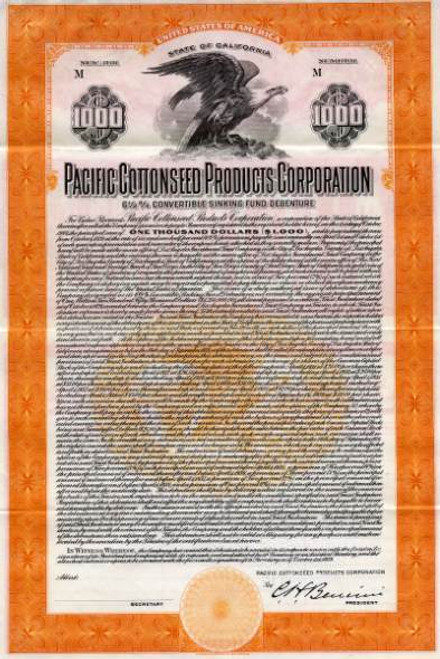Historic unissued SCARCE stock certificate from United Artists Studio Corporation printed in the 1920's. This historic document was printed by Crocker-Union and has an ornate border around it with a vignette of the company name. United Artist was organized as a joint venture on February 5, 1919 by four of the leading figures in early Hollywood: Charles Chaplin, Douglas Fairbanks, Mary Pickford, and D. W. Griffith. The idea for the venture originated with Fairbanks, Chaplin, Pickford, and cowboy star William S. Hart a year earlier as they were traveling around the U.S. selling Liberty bonds to help the World War I effort. Already hardened veterans of Hollywood, the four film stars began to talk of forming their own company to better control their own work as well as their futures. With the addition of Griffith, planning began, but Hart bowed out even before things had formalized. When he heard about their scheme, Richard A. Rowland, head of Metro Pictures, said, "The inmates are taking over the asylum." The four partners, with advice from former Secretary of the Treasury William G. McAdoo (son-in-law of then-President Woodrow Wilson), formed their distribution company, with Hiram Abrams as its first managing director. The original terms called for Pickford, Fairbanks, Griffith and Chaplin to produce five pictures each year. But by the time the company got under way in 1920-1921, feature films were becoming more expensive and more polished, and running times had settled at around ninety minutes (or eight reels). It was soon clear that no one, no matter how popular, could produce and star in five films a year. By 1924, by which time Hart and Griffith had dropped out, the company was facing a crisis: either bring in others to help support a costly distribution system or concede defeat. The veteran producer Joseph Schenck was hired as president. Not only had he been producing pictures for a decade, but he brought along commitments for films starring his wife, Norma Talmadge, his sister-in-law, Constance Talmadge, and his brother-in-law, Buster Keaton. Contracts were signed with a letter of independent producers, especially Samuel Goldwyn, Alexander Korda and Howard Hughes. Schenck also formed a separate partnership with Pickford and Chaplin to buy and build theaters under the United Artists name. United Artists expanded to include are nine producers -- Mary Pickford, Douglas Fairbanks, Charles Chaplin, D. W. Griffith, Gloria Swanson, Samuel Goldwyn, Feature Productions, Inc., Art Cinema Co., and United Artists Studios, Inc. By 1938 Samuel Goldwyn had accumulated over 50 percent of the stock and changed the name to Samuel Goldwyn Studios. Feature Productions produced "The Son of the Sheik" in 1926. Directed by: George Fitzmaurice. Cast: Rudolph Valentino, Vilma Banky, George Fawcett, Montague Love, Bull Montana. It was Rudolph Valentino's last film. Sorrell and Son (1927) was alos produced by Feature Productions. Distributor: United Artists. Presenter: Joseph M. Schenck. Director-Scenario: Herbert Brenon. Adaptation: Elizabeth Meehan. Photography: James Wong Howe. Set Design: Julian Boone Fleming. Editor: Marie Halvey. Assistant Director: Ray Lissner. Makeup: Fred C. Ryle. Cast: H.B. Warner, Anna Q. Nilsson, Mickey McBan, Carmel Myers, Lionel Belmore, Norman Trevor, Betsy Ann Hisle, Louis Wolheim, Paul McAllister, Alice Joyce, Nils Asther, Mary Nolan. Man suffers privations as he raises son alone, who grows up to be a surgeon. 10 reels, 9,900 ft. This film was recently rediscovered and restored (Academy Film Archive, poor image quality, last 5 minutes missing) The Bat (1926) Directed by Roland West was also produced by Feature Productions, Incorporated, production; distributed by United Artists Corporation. / Produced by Joseph M. Schenck. Scenario by Roland West with continuity by Julien Josephson, from the play adaptation The Bat by Mary Roberts Rinehart and Avery Hopwood of the novel The Circular Staircase by Mary Roberts Rinehart. Production design by William Cameron Menzies. Production assistants Frank Hall Crane, Hal C. Kern, Thornton Freeland and Ned Herbert Mann. Cinematography by Arthur Edeson. Intertitles by George Marion Jr. / © 23 March 1926 by Feature Productions, Incorporated [LP22528]. New York premiere circa 14 March 1926. Released 5 April 1926. Roland West remake this film as The Bat Whispers (1930). Cast: André de Béranger (André Beranger) [Gideon Bell], Charles W. Herzinger [the man in the black mask], Emily Fitzroy [Miss Cornelia Van Gorder], Louise Fazenda [Lizzie Allen], Arthur Houseman [Richard Fleming], Robert McKim [Dr. Wells], Jack Pickford [Brooks Bailey], Jewel Carmen [Miss Dale Ogden], Sojin Kamiyama [Billy], Tullio Carminati [Moletti], Eddie Gribbon [Detective Anderson], Lee Shumway [The Unknown] Edwin J. Loeb was one of the original founders of the International Academy of Motion Picture Arts and Sciences (the "International" was later dropped during incorporation proceedings). The thirty-six included Mayer, Nagel, Niblo, and Beetson, J.A. Ball, Richard Barthelmess, Charles H. Christie, George Cohen, Cecil B. DeMille, Douglas Fairbanks, Joseph W. Farnham, Cedric Gibbons, Benjamin Glazer, Sid Grauman, Milton Hoffman. Jack Holt, Henry King, Jesse Lasky, M.C. Levee, Frank Lloyd, Harold Lloyd, Edwin J. Loeb, Jeanie MacPherson, Bess Meredyth, Mary Pickford, Roy Pomeroy, Harry Raph, Joseph Schenck, Milton Sills, John Stahl. Irving Thalberg, Raoul Walsh, Harry Warner, Jack L. Warner, Carey Wilson and Frank Woods. History from StockResearch.pro (Professional Old Stock Certificate Research Service).
United Artists Studio Corporation - California 1920's
MSRP:
$189.95
$149.95
(You save
$40.00
)
- SKU:
- newitem91736754
- Gift wrapping:
- Options available








